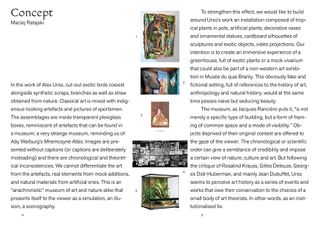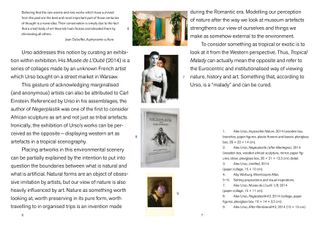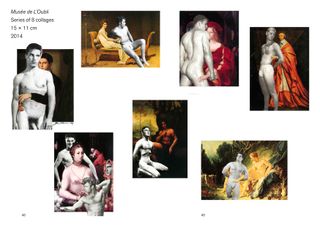Tropical Malady was a curatorial project proposal by Maciej Ratajski for Alex Urso's solo exhibition at Miejsce Projektów Zachęty in Warsaw. It's title referenced both a 2004 movie, Tropical Malady by Apichatpong Weerasethakul, and a 1920 play by Stanisław Ignacy Witkiewicz, Mister Price, czyli Bzik tropikalny [Mr Price, or Tropical Madness] inspired by Witkiewicz's own famous expedition through exotic lands with anthropologist Bronisław Malinowski.
In the work of Alex Urso, cut-out exotic birds coexist alongside synthetic scraps, branches as well as straw obtained from nature. Classical art is mixed with indigenous-looking artefacts and pictures of sportsmen. The assemblages are inside transparent plexiglass boxes, reminiscent of artefacts that can be found in a museum; a very strange museum, reminding us of Aby Warburg’s Mnemosyne Atlas. Images are presented without captions (or captions are deliberately misleading) and there are chronological and theoretical inconsistencies. We cannot differentiate the art from the artefacts, real elements from mock additions, and natural materials from artificial ones. This is an “anachronistic” museum of art and nature alike that presents itself to the viewer as a simulation, an illusion, a scenography.
To strengthen this effect, we would like to build around Urso’s work an installation composed of tropical plants in pots, artificial plants, decorative vases and ornamental statues, cardboard silhouettes of sculptures and exotic objects, video projections. Our intention is to create an immersive experience of a greenhouse, full of exotic plants or a mock vivarium that could also be part of a non-western art exhibition in Musée du quai Branly. This obviously fake and fictional setting, full of references to the history of art, anthropology and natural history, would at the same time posses naive but seducing beauty.
The museum, as Jacques Rancière puts it, “is not merely a specific type of building, but a form of framing of common space and a mode of visibility.” Objects deprived of their original context are offered to the gaze of the viewer. The chronological or scientific order can give a semblance of credibility and impose a certain view of nature, culture and art. But following the critique of Rosalind Krauss, Gilles Deleuze, Georges Didi-Huberman, and mainly Jean Dubuffet, Urso seems to perceive art history as a series of events and works that owe their conservation to the choices of a small body of art theorists. In other words, as an institutionalised lie.
Believing that the rare events and rare works which have survived from the past are the best and most important part of those centuries of thought is a naive idea. Their conservation is simply due to the fact that a small body of art theorists had choices and elevated them by eliminating all others.
— Jean Dubuffet, Asphyxiante culture
Urso addresses this notion by curating an exhibition within exhibition. His Musée de L'Oubli (2014) is a series of collages made by an unknown French artist that Urso bought on a street market in Warsaw.
This gesture of acknowledging marginalised (and anonymous) artists can also be attributed to Carl Einstein. Referenced by Urso in his assemblages, the author of Negerplastik was one of the first to consider African sculpture as art and not just as tribal artefacts. Ironically, the exhibition of Urso’s works can be perceived as the opposite — displaying western art as artefacts in a tropical scenography.
Placing artworks in this environmental scenery can be partially explained by the intention to put into question the boundaries between what is natural and what is artificial. Natural forms are an object of obsessive imitation by artists, but our view of nature is also heavily influenced by art. Nature as something worth looking at, worth preserving in its pure form, worth travelling to in organised trips is an invention made during the Romantic era. Modelling our perception of nature after the way we look at museum artefacts strengthens our view of ourselves and things we make as somehow external to the environment.
To consider something tropical or exotic is to look at it from the Western perspective. Thus, Tropical Malady can actually mean the opposite and refer to the Eurocentric and institutionalised way of viewing nature, history and art. Something that, according to Urso, is a “malady” and can be cured.
Ratajski's curatorial project proposal was later developed by Magda Kardasz and Karolina Bielawska into the Egzotyczne? [Exotic?] exhibition at Miejsce Projektów Zachęty with artists such as Tomek Kopcewicz, Michał Szlaga, Karolina Mełnicka, Daniel Rumiancew, Alex Urso and Rafał Żarski.



